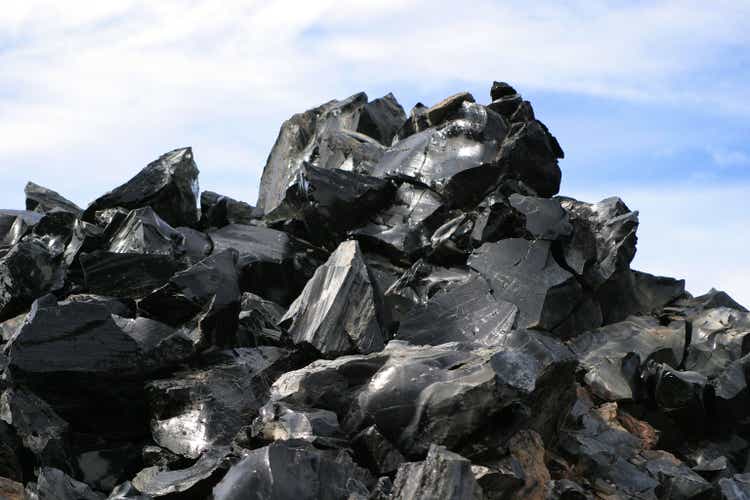mgdwn
Obsidian Energy (NYSE:OBE) lowered its full-year production guidance, largely due to the impact of the Alberta wildfires. It also reduced its expectations for full year free-cash flow to CAD$65 million (US$49 million) from its previous expectations for CAD$105 million CAD (US$79 million) in 2023 free cash flow.
The lowered free cash flow expectations were due to its revised production guidance as well as Obsidian reduction its commodity price expectations for the rest of the year to US$75 oil.
I had already accounted for the impact of wildfires on Obsidian’s production, although it also noted a couple other issues that further reduced its projected 2023 production by a bit. I had also projected Obsidian’s 2023 free cash flow at US$45 million, slightly below Obsidian’s revised estimate.
The oil strip for the remainder of 2023 is above US$80 now, so at strip Obsidian may actually be able to generate around US$65 million in free cash flow in 2023. This is around US$20 million better than what I expected at the beginning of June, and increases Obsidian’s estimated value to US$8.25 per share at long-term US$75 WTI oil.
Unless otherwise mentioned, this report uses US dollars, with an exchange rate of US$1.00 to CAD$1.33.
Q2 2023 Results
As anticipated, Obsidian’s Q2 2023 production took a significant hit due to the impact of Alberta wildfires. It reported 31,042 BOEPD in Q2 2023 production, with 2,100 BOEPD in impact from the wildfires.
This is actually slightly better than I expected, as I had been modeling a 600 BOEPD full-year impact from the wildfires, translating into approximately 2,400 BOEPD in Q2 2023 impact.
Obsidian also reported CAD$43 million (US$32 million) in free cash flow in Q2 2023. This was helped by its 1H 2023 capex budget being heavily weighted (73%) to Q1. Due to the large amount of capex in Q1, Obsidian’s free cash flow was negative during that quarter. Obsidian’s 1H 2023 free cash flow came it at US$16 million, so it may be able to generate US$49 million in free cash flow in 2H 2023 at current strip.
Guidance Changes
Obsidian revised its full-year production guidance downwards by 500 to 1,000 BOEPD to reflect the impact of the wildfires as well as a couple other items. It mentioned that the shut-in of a third-party facility affected nine of its Permian wells and may reduce its 2023 production by 120 BOEPD, although it is looking at options to bring those wells back on production. It also deferred its Willesden Green infrastructure debottlenecking project to Q4 2023 in an attempt to take advantage of higher winter gas prices. This change reduces Obsidian’s expected 2023 production by approximately 200 BOEPD.
Obsidian has also reduced its free cash flow guidance for 2023 by CAD$40 million CAD (US$30 million), due to a combination of the reduced production expectations and lowered commodity pricing assumptions. Obsidian now is assuming US$75 WTI oil and CAD$2.50/GJ AECO gas from August to December, compared to its earlier assumptions for US$80 WTI oil and CAD$3.00/GJ AECO gas.
Note And Share Repurchases
Obsidian has also been repurchasing a small amount of its unsecured notes. It repurchased CAD$4.1 million (US$3.1 million) in notes on the open market for a slight discount (98.6% of par) in Q2 2023 and July 2023. It also announced an offer to repurchase up to CAD$5 million (US$3.8 million) in unsecured notes for 103% of par.
These note repurchases do not significantly affect Obsidian’s current net debt or interest costs as they involve a fairly small amount of note principal. Obsidian’s unsecured notes have a high interest rate of 11.95% and it is using credit facility debt with a slightly lower interest rate to help it repurchase those notes. Repurchasing a total of CAD$9.1 million (US$6.9 million) in notes may save Obsidian around US$0.2 million in interest costs per year.
Obsidian’s notes have a semi-annual repurchase offer feature, which requires it to offer to repurchase an amount based on its excess free cash flow at a price of 103% of par.
Obsidian has also been repurchasing shares under its normal course issuer bid. As of early August, it noted that it had repurchased 2.206 million shares at an average price of CAD$8.27 US($6.22) per share.
Valuation
I’ve slightly increased Obsidian’s estimated value to US$8.25 per share based on my long-term commodity prices of US$75 WTI oil and CAD$3.75 AECO natural gas.
I had already assumed that Obsidian’s 2023 production would end up around 600 BOEPD lower than previously expected due to the wildfires, so its 500 to 1,000 BOEPD guidance reduction was largely accounted for in my calculations.
As well, Obsidian’s 2023 free cash flow should end up higher than my previous estimates due to recent improvements in oil prices.
Conclusion
Obsidian Energy reduced its 2023 free cash flow expectations to around US$49 million per year, assuming US$75 WTI oil during the remainder of the year. With WTI strip above US$80, it may be able to generate around US$65 million in free cash flow for the full year, which would also mean US$49 million in free cash flow during 2H 2023.
The improved free cash flow expectations for 2023 (compared to when I looked at it with early June strip prices) increases Obsidian’s estimated value to approximately US$8.25 per share at long-term US$75 WTI oil.









